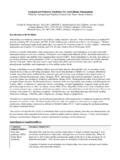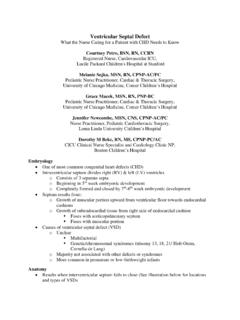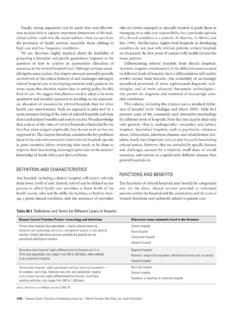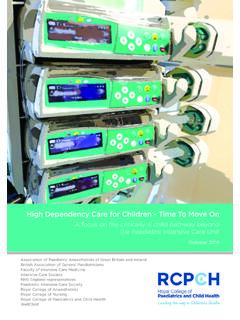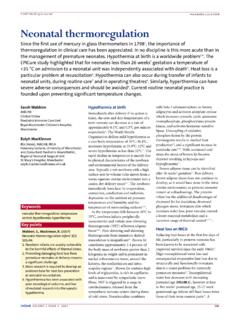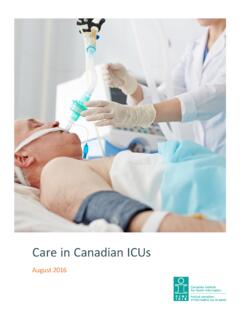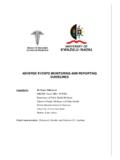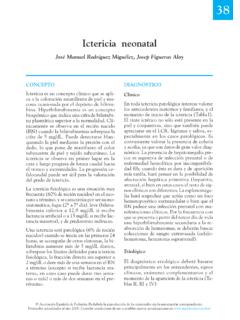Transcription of Care of the Patient with Temporary Pacemaker In the ...
1 care of the Patient with Temporary Pacemaker In the neonatal and Pediatric Cardiac Patient What the Nurse Caring for a Patient with Congenital Heart Disease Needs to Know Christine Chiu-Man, MSc, RCT, RCES, CEPS, CCDS, FHRS, Team Lead EP Pacemaker Technologist, Hospital for Sick Children, Toronto Sandra McGill-Lane, MSN, RN, FNP, CCRN. Clinical Nurse Specialist, Pediatric Cardiac intensive care Unit Morgan Stanley's Children's Hospital of NY-Presbyterian Catherine Murphy, BSN, RN. Staff Nurse, Cardiac Critical care Unit. Labatt Family Heart Centre Hospital for Sick Children, Toronto Melissa Olen, MSN, ARNP, FNP-C, CCRN. Electrophysiology NP, Coordinator of Remote Device Clinic Nicklaus Children's Hospital, Miami, Florida Elizabeth Daley, BA, BSN, RN, CCRN, RN III, Cardiothoracic intensive care Unit Children's Hospital of Los Angeles Cecilia St. George-Hyslop, M Ed, RN, BA Gen.
2 , CNCCPC. Advanced Nursing Practice Educator, Cardiac Critical care Unit, Labatt Family Heart Centre Hospital for Sick Children, Toronto Introduction A Pacemaker is an electronic device which provides repetitive electrical stimuli to the right atrium (RA) or right ventricle (RV) and in dual chamber atrioventricular (AV) pacing, both. Single and dual chamber AV sequential pacing initiates and maintains the heart rate (HR) when the natural Pacemaker , the sinoatrial (SA) node fails to fire is delayed or does not conduct regularly to the ventricles as in advanced AV block. Postoperative cardiac arrhythmias are a major cause of morbidity and mortality in pediatric patients following repair of congenital heart defects (CHD). (Batra, 2008) Post-operative surgical trauma and/or surgical swelling are common and therefore some patients may require Temporary Pacemaker therapy support.
3 These guidelines review the management of patients with a Temporary Pacemaker . Nurses are encouraged to review their institutional policies and guidelines prior to caring for patients with pacemakers. Nurses are encouraged to review their institutional policies and guidelines prior to caring for patients with pacemakers. Please refer to the Society of Pediatric Cardiovascular Nurses (SPCN)/ Pediatric Cardiac intensive care Society (PCICS) guidelines on Arrhythmia Management, Postoperative care , and guidelines on specific Congenital Heart Defects. 1. Critical Thinking Points Nurses caring for infants and children requiring permanent Pacemaker therapy must be competent with Pacemaker technology. Competency includes: o Knowledge of the types of pacemakers o Knowledge of programmed modes o Understanding of parameter settings o Capability to recognize and interpret normal/abnormal device function.
4 Nurses must understand the Patient 's o Underlying cardiac rhythm and myocardial function o Degree of device dependency o Interpretation of intrinsic and paced electrocardiograms o Patient response to pacing (cardiac output). o Fundamental skills include: Recognizing complications Failure to pace Failure to capture Failure to sense (undersensing and oversensing). Recognizing changes in Patient 's clinical condition when device may be a contributing factor Nurses should have the following basic knowledge o Knowledge of appropriate heart rate for age in pediatrics o Knowledge of pediatric cardiac arrhythmias o Understand pediatric congenital and acquired heart disease and associated acute and chronic electro-physiologic sequelae o Appreciate the surgical history, cardiac anatomy and acute and chronic electro physiologic sequelae as a result of cardiac repair Definitions Temporary Pacemaker : Control box external to the Patient and used in conjunction with Temporary pacing catheter or lead(s) to help control heart rhythm.
5 Epicardial Lead(s): lead(s) attached to the hearts epicardial surface. Endocardial Lead(s): pacing lead(s) enters into the heart chambers via a transvenous approach. Inhibited: The Pacemaker does not pace when it senses an intrinsic beat. Triggered: When the Pacemaker does not sense an event within a set amount of time an electrical current is delivered Indications for Temporary Pacing Sinus node dysfunction with failure of the SA node to generate an appropriate heart rate response. Persistent bradycardia despite oxygen administration, breathing and chronotropic drug administration. (Hazinski, 2012). Junctional and ventricular escape rhythms Advanced AV block Congenital or acquired heart disease 2. Congestive heart failure (CHF). Drug effects Hypoxic ischemic damage to the cells Electrolyte imbalance Types of Temporary Pacing Epicardial pacing: leads attached to the epicardial surface of the heart via the thorax Transvenous pacing: leads inside the heart accessed through the veins Transcutaneous pacing: multifunction pads attached to the skin on the thorax, from a defibrillator with shock and pacing capabilities.
6 This form of pacing provides ventricular demand (VVI) or fixed rate (VOO) pacing only. Esophageal pacing: an electrode passed down the esophagus and positioned directly behind the left atrium (LA). Used for emergency atrial demand pacing (AAI) for sinus bradycardia or alternatively for rapid atrial overdrive pacing of supraventricular tachycardia, (SVT) and atrial flutter. (Hazinski, 2012). Pacing Coding System A standardized generic coding system was established by the North American Society of Pacing and Electrophysiology (NASPE) and the British Pacing and Electrophysiology Group (BPEG) for anti-bradycardia pacing, adaptive rate and multisite pacing. The Revised NASPE and BPEG Pacemaker Codes Temporary I II III. Chamber(s) Paced Chamber(s) Sensed Mode(s) of Response A=Atrium A=Atrium T=Triggered V=Ventricle V=Ventricle I=Inhibited D=Dual (A&V) D=Dual D=Dual (A&V) Triggered/Inhibited O=None O=None O=None Bernstein, et al.
7 , 2002. Position I: Refers to the specific chamber(s) being paced. The letter signifies the chamber: Atrium, Ventricular, and Dual or both. Position II: Refers to the specific chamber(s) being sensed for intrinsic signals. Position III: Action based on response to intrinsic signals that were sensed or not sensed (Position II). 3. Inhibited mode will withhold output from the Pacemaker if an appropriate timed intrinsic signal is sensed, if not it will deliver output. Triggered mode will provide output from the Pacemaker after a programmed time interval from a sensed event. This is a very uncommon setting, mostly used during testing. Dual mode is dependent on what chambers are sensed (most often Dual sensed), in order to provide atrioventricular synchrony. (Miller, 2002). Dual mode uses both inhibited and triggered mode to function, as previously stated to provide atrioventricular synchrony.
8 None mode, being zero action is taken. Temporary Pacemaker Codes: Identified by a 3 letter coding system: (AOO, VOO, DOO, AAI, VVI, DDD, and DDI). Common Temporary pacing modes are AAI, VVI, and DDD. AAI means the Pacemaker paces and senses in the atrium and inhibits atrial pacing upon sensing an intrinsic atrial event. VVI means the Pacemaker paces and senses in the ventricle and will inhibit ventricular pacing upon a sensed ventricular event. DDD means pacing and sensing occur in the atrium and ventricle, and the Pacemaker will inhibit from atrial pacing upon a sensed P-wave. It will also track the P-wave with ventricular pacing (triggered) should a QRS not come within the specified AV interval (msec). A sensed R- wave will inhibit ventricular pacing. Demand Pacing Demand pacing is the preferred form of pacing as it senses the Patient 's intrinsic rhythm preventing competition between intrinsic and paced beats.
9 The sensitivity setting if set inappropriately causes inappropriate pacing. AAI, VVI, DDD, and DDI are examples of demand pacing which inhibit or pace in response to sensed activity. Fixed Rate (Asynchronous) Pacing AOO, VOO, and DOO are modes that have no capability to sense the Patient 's intrinsic beats and so the Pacemaker paces at a preset rate independent of the Patient 's rhythm. If the intrinsic heart rate rises above the paced rate, there can be competition between the Pacemaker and the intrinsic rhythm. This can result in the Pacemaker firing at inappropriate times and producing an R on T phenomenon. R on T is where the Pacemaker fires and produces a QRS during the vulnerable T wave, possibly precipitating ventricular tachycardia or ventricular fibrillation. Lack of sensed atrial beats may lead to atrial arrhythmias such as atrial fibrillation and flutter.
10 General Principles Placement of Temporary pacing leads o Prophylactic placement of epicardial leads in the operating room (OR) (Everett, 2010). Common in infants and young children Patients with prosthetic valves Patients with a single ventricle o Transvenous pacing catheters may be used for patients who need emergent pacing. Access may be via jugular or subclavian vein. 4. o Transesophageal pacing is rarely used for extensive Temporary pacing due to higher output requirements and Patient discomfort caused by the pacing. Standard placement for dual chamber transthoracic (epicardial) leads o Atrial leads placed on the epicardial surface of the right atrium (RA). o Ventricular leads on the surface of the right ventricle (RV). o Pacing wires brought through the skin and sutured to the thorax Atrial leads usually to the right side Ventricular leads to the left side This can be reversed in patients with dextrocardia (Reade, 2007).

